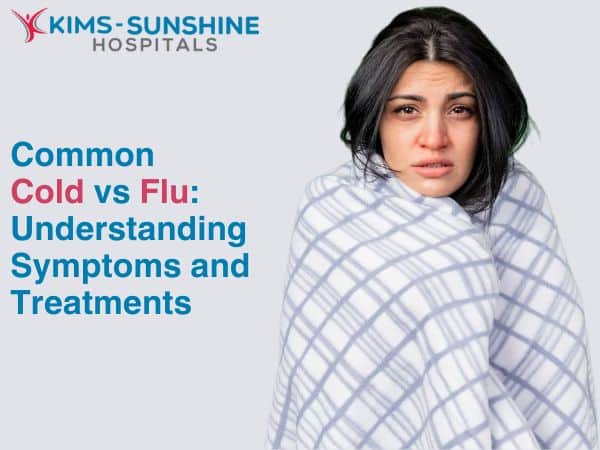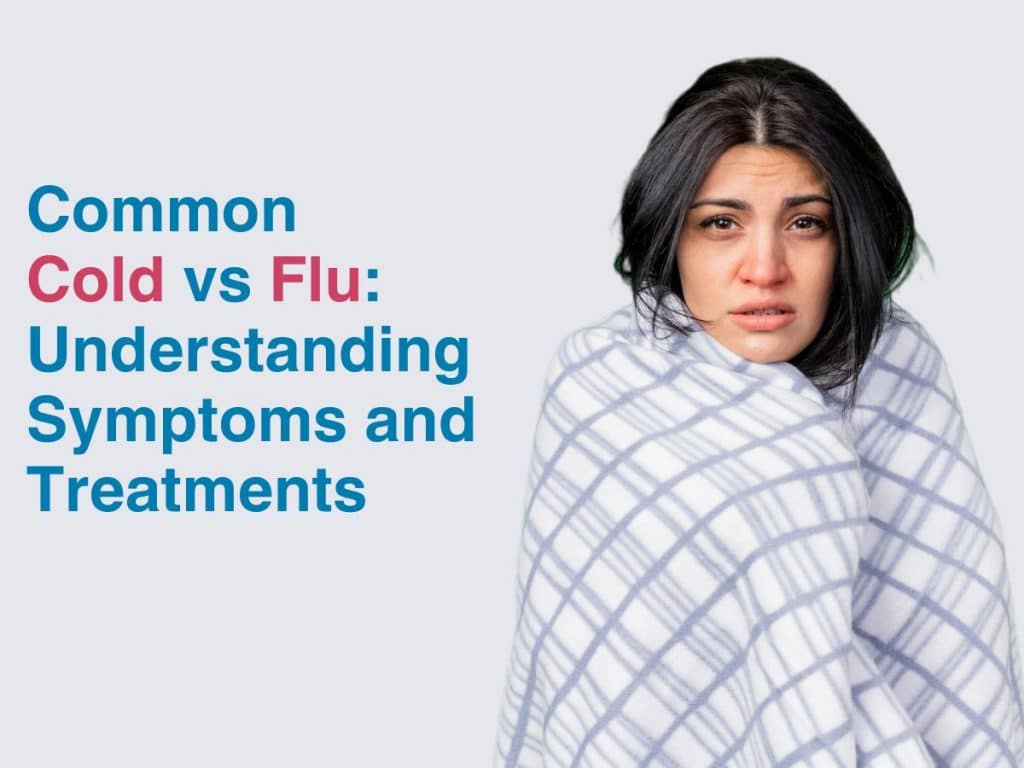
Common Cold vs. Flu: Understanding Symptoms and Treatments
 Winter means two things: sweaters and a slew of infections!
Winter means two things: sweaters and a slew of infections!
Two of the most common culprits for the latter are the common cold and the flu.
While these illnesses share some symptoms, they have distinct differences that affect how we manage and treat them.
This blog will help you understand the difference between cold and flu symptoms, how to tell if you have a cold or the flu, and provide treatments and preventive measures to keep you healthy during the cold and flu season.
Difference Between Cold and Flu Symptoms
Understanding the symptoms of the common cold and the flu is essential for effective treatment and management.
Here are the key differences:
Common Cold Symptoms:
- Gradual onset
- Mild fatigue
- Runny or stuffy nose
- Sore throat
- Sneezing
- Mild to moderate cough
- Mild headache
Flu Symptoms:
- Sudden onset
- Severe fatigue
- High fever (often over 101°F)
- Chills
- Body and muscle aches
- Dry, persistent cough
- Severe headache
- Sometimes nausea and vomiting (more common in children)
How to Tell If You Have a Cold or the Flu
Determining whether you have a cold or the flu can be challenging due to overlapping symptoms. Here are some pointers to help you distinguish between the two:
Onset of Symptoms: Flu symptoms tend to appear suddenly, while cold symptoms develop gradually.
Fever: A high fever is more characteristic of the flu, whereas a fever is rare in adults with a cold.
Body Aches and Fatigue: Severe body aches and fatigue are more common with the flu.
Cough: While both illnesses can cause a cough, a dry and persistent cough is more indicative of the flu.
Treatments for Common Cold vs. Flu
The treatment approaches for colds and the flu differ due to the nature of the viruses causing them.
Common Cold Treatments:
- Rest and hydration
- Over-the-counter (OTC) medications such as decongestants, antihistamines, and pain relievers
- Throat lozenges and honey for sore throat relief
- Steam inhalation to ease congestion
Flu Treatments:
- Antiviral medications (e.g., oseltamivir) if prescribed by a doctor
- Rest and increased fluid intake
- OTC medications for symptom relief (similar to those used for colds)
- Medical attention for severe cases or high-risk groups (e.g., young children, elderly, those with chronic conditions)
Flu Symptoms That Are Not Common in Colds
Certain symptoms are more commonly associated with the flu and are rare in colds:
- High fever
- Severe headaches
- Intense body and muscle aches
- Chills
- Nausea and vomiting (more frequent in children)
How Long Does a Cold Last vs. the Flu
The duration of illness also varies between the common cold and the flu:
Common Cold: Symptoms usually last about 7-10 days, with some lingering effects such as a cough or congestion potentially lasting up to two weeks.
Flu: Symptoms typically improve within 5-7 days, but fatigue and weakness can persist for several weeks.
How to Prevent Cold and Flu During Winter
Preventing these illnesses involves a combination of good hygiene practices and proactive measures:
- Frequent handwashing with soap and water
- Using hand sanitizers with at least 60% alcohol when soap is unavailable
- Avoiding close contact with sick individuals
- Disinfecting frequently touched surfaces
- Getting the annual flu vaccine
- Maintaining a healthy diet and regular exercise to strengthen the immune system
Natural Remedies for Cold vs. Flu
While natural remedies can’t cure these illnesses, they can alleviate symptoms and support recovery:
For Colds:
- Honey and lemon in warm water for sore throat
- Zinc supplements
- Herbal teas with ginger and peppermint
For Flu:
- Increased intake of vitamin C-rich foods
- Hydration with electrolyte-rich drinks
Cold and Flu Season Tips
Here are additional tips to navigate through the cold and flu season:
- Dress warmly to prevent chills that can weaken the immune system
- Stay hydrated to help maintain bodily functions and flush out toxins
- Ensure adequate sleep to boost the immune response
- Avoid sharing personal items like utensils and towels
- Stay home when feeling unwell to prevent the spreading of illness
Conclusion
Understanding the differences between the common cold and the flu is crucial for effective treatment and prevention. By recognizing the distinct symptoms and implementing the appropriate remedies and preventive measures, you can better manage your health during the cold and flu season. Stay vigilant, practice good hygiene, and take care of your body to stay healthy throughout the winter months.






